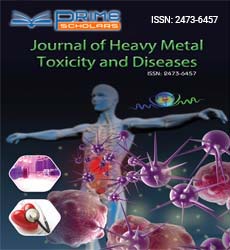Perspective - (2024) Volume 9, Issue 5
Biosensors for Monitoring Heavy Metals: Innovations in Detecting and Monitoring Toxicity Levels
Sherlock Robert*
Department of Toxicology, Andhra University, India
*Correspondence:
Sherlock Robert,
Department of Toxicology, Andhra University,
India,
Email:
Received: 01-Oct-2024, Manuscript No. ipjhmct-24-21855;
Editor assigned: 03-Oct-2024, Pre QC No. ipjhmct-24-21855 (PQ);
Reviewed: 17-Oct-2024, QC No. ipjhmct-24-21855;
Revised: 22-Oct-2024, Manuscript No. ipjhmct-24-21855 (R);
Published:
29-Oct-2024, DOI: 10.21767/2473-6457.24.5.42
Introduction
Heavy metal exposure poses significant health risks, with
elements such as lead, mercury, cadmium, and arsenic known
to cause a range of acute and chronic health issues. Early
detection and monitoring of heavy metal levels in the body are
crucial for preventing toxicity and facilitating timely intervention.
Biosensors, which are analytical devices that combine biological
components with physicochemical detectors, have emerged as
promising tools for the rapid and accurate monitoring of heavy
metal concentrations in biological samples. This article explores
the development of biosensors for detecting heavy metal levels
in the body, their mechanisms, advantages, and future prospects.
Description
Heavy metals are naturally occurring elements that can be toxic
when present at elevated levels in the human body. They can
enter the system through various routes, including ingestion,
inhalation, and dermal contact. Common sources of exposure
include contaminated food, water, industrial pollutants, and
occupational hazards. Symptoms of heavy metal toxicity can
range from gastrointestinal disturbances and neurological
impairment to severe organ damage and increased cancer risk.
Given the diverse and potentially severe health effects, effective
monitoring is essential. Biosensors are designed to detect
specific analytes through biological recognition elements, such as
enzymes, antibodies, or nucleic acids, coupled with a transducer
that converts the recognition event into a measurable signal. The
development of biosensors for heavy metal detection leverages
various mechanisms, including electrochemical, optical, and
mass-sensitive methods. Electrochemical biosensors are the
most widely used biosensors for detecting heavy metals. They
operate by measuring changes in current, voltage, or impedance
in response to the presence of specific metal ions. For instance,
a sensor may utilize a specific enzyme that reacts with heavy
metal ions, resulting in a measurable electrical signal. These
sensors are favoured for their sensitivity, rapid response time,
and ease of miniaturization. Optical biosensors detect changes
in light properties, such as fluorescence or absorbance, when
heavy metal ions bind to a specific recognition element. For
example, quantum dots or gold nanoparticles can be engineered
to emit fluorescent signals upon interaction with specific metals,
providing a visual indication of contamination. Biosensors
provide quick results, enabling timely decisions regarding health
interventions. The use of specific biological recognition elements
enhances the accuracy of detection, minimizing false positives
and negatives. Many biosensors are designed to be portable,
allowing for point-of-care testing. This is particularly valuable in
field settings or for individuals in remote areas who may have
limited access to healthcare facilities. Compared to traditional
analytical methods, biosensors can offer a more affordable
solution for routine monitoring of heavy metals, making them
accessible for wider use in public health. Many biosensor devices
are designed to be easy to use, requiring minimal training. This
allows individuals, such as patients and healthcare workers, to
perform tests without specialized laboratory skills. Biological
components used in biosensors can degrade over time, affecting
the accuracy and reliability of measurements. Ensuring longterm
stability and shelf life is crucial for practical applications.
Conclusion
Biosensors represent a groundbreaking approach to detecting
and monitoring heavy metal levels in the body. With their rapid
response times, high sensitivity, and potential for portability, these
devices offer a valuable tool for preventing and managing heavy
metal toxicity. As research and technology continue to evolve,
biosensors will play an increasingly vital role in safeguarding
public health and ensuring early intervention for those at risk
of heavy metal exposure. By investing in the development
and implementation of these innovative technologies, we can
enhance our ability to protect communities from the dangers of
heavy metal contamination.
Citation: Robert S (2024) Biosensors for Monitoring Heavy Metals: Innovations in Detecting and Monitoring Toxicity Levels. J Heavy Met Toxicity Dis. 09:42.
Copyright: © 2024 Robert S. This is an open-access article distributed under the terms of the Creative Commons Attribution License, which permits unrestricted use, distribution, and reproduction in any medium, provided the original author and source are credited.

